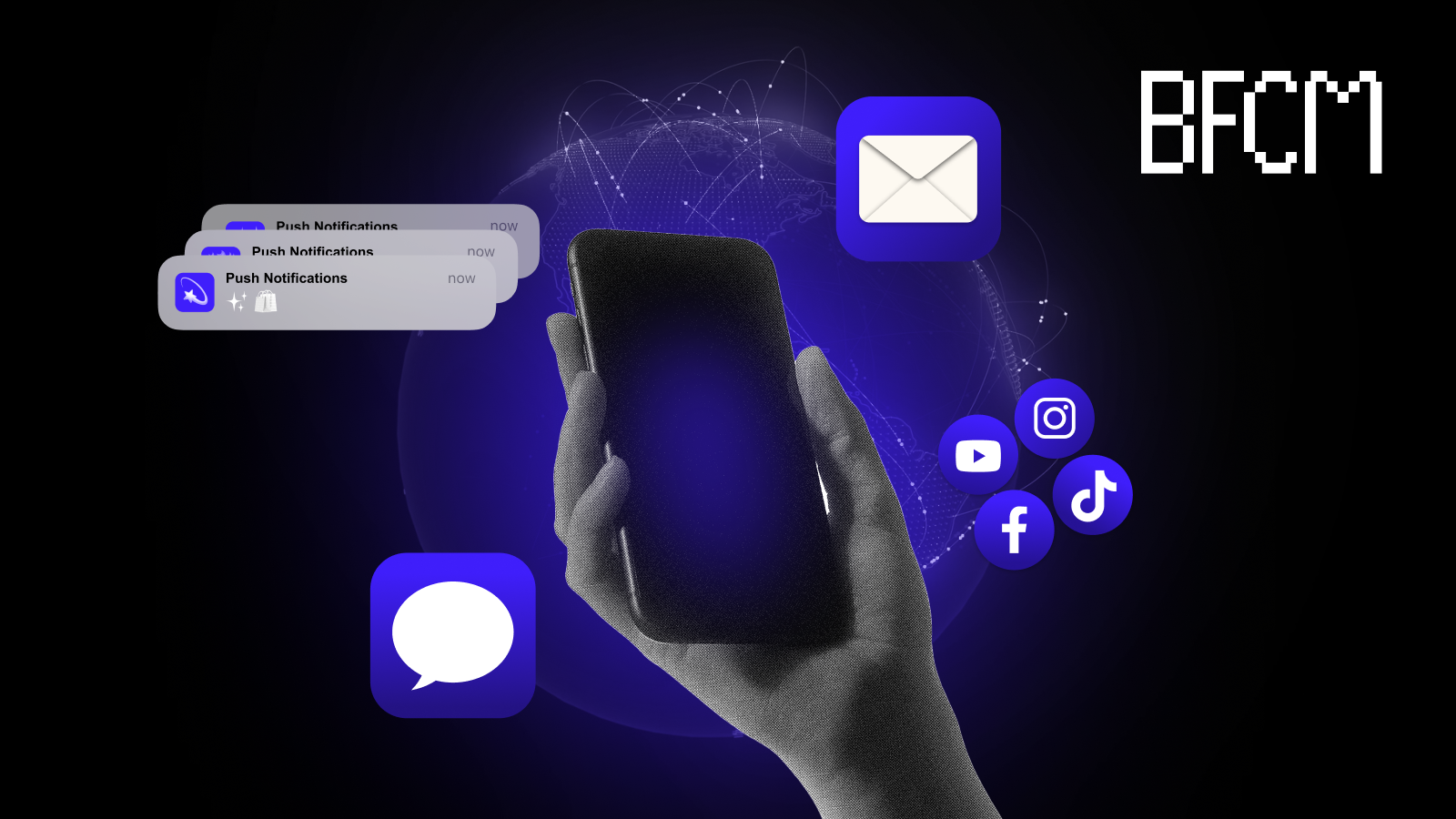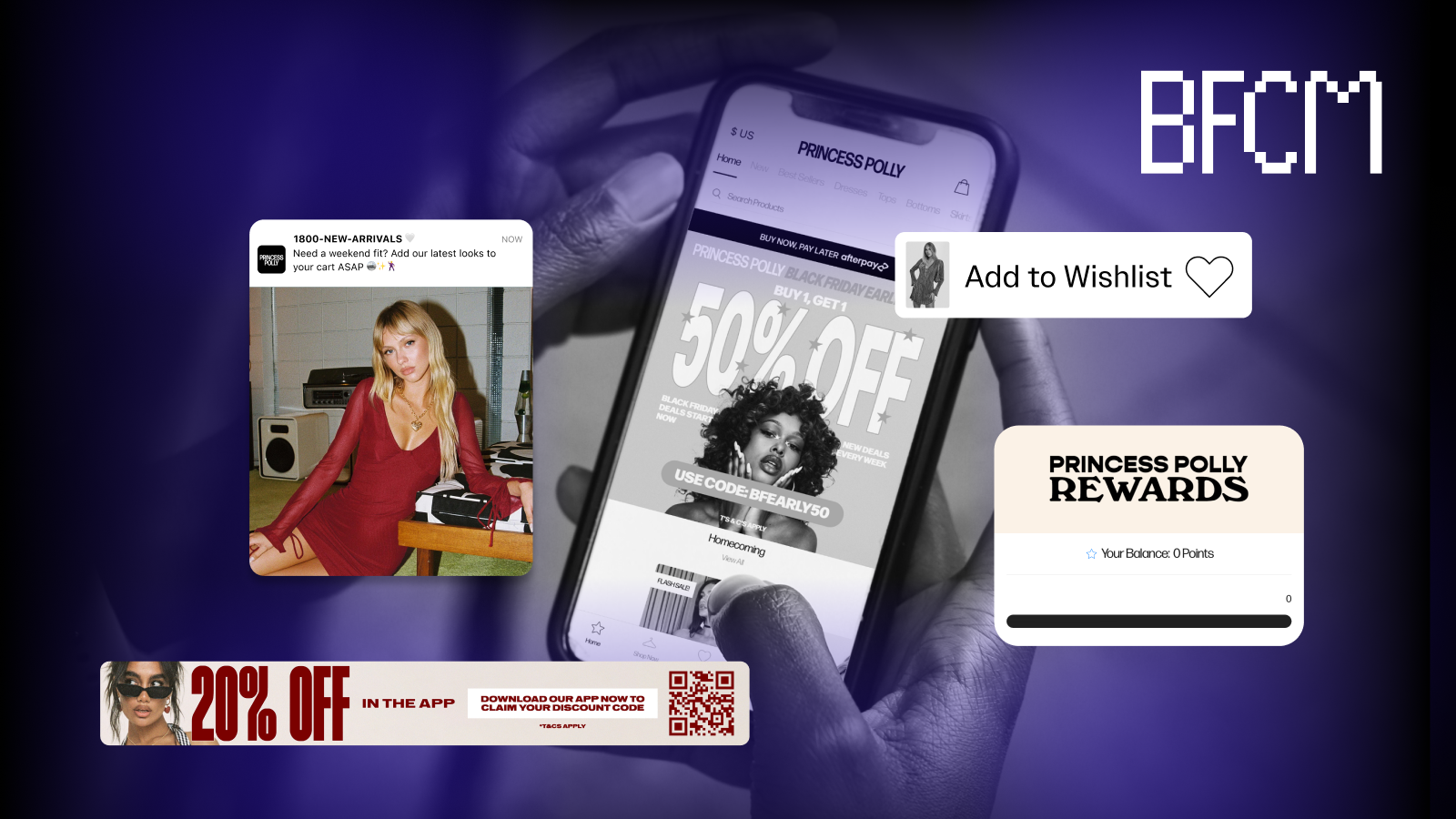
The calendar is counting down toward the busiest shopping weekend of the year: Black Friday Cyber Monday (BFCM). Every powerhouse ecommerce brand knows it’s nearly game time, and your advertising strategy is likely well underway.
But let’s get real. BFCM advertising isn’t about unleashing a barrage of emails and advertising and waiting for that Shopify cha-ching. The modern shopper is savvy, traversing the digital realms, searching for the best gifts with the best deals. How do you get their attention (and get them to check out) without spending your entire marketing budget in one go?
With a strategy that goes beyond channels and connects with shoppers at every turn: omnichannel marketing.
While you already weave omnichannel marketing into your
While your customer journey is likely based on omnichannel marketing, we’ll show how to leverage it for BFCM 2024: which ads work best this year and how to combine them to build a dynamic marketing strategy.
Let’s dive in.
Consumers are paying attention to your BFCM ads
In the BFCM Consumer Trends 2024 report, we surveyed 1,161 people about their shopping habits and expectations for BFCM.
One big surprise (but also not a surprise) was how many people are genuinely excited to get BFCM ads.

An impressive 94% of shoppers reported they feel at least a little excited to see BFCM ads. Only 7% reported feeling very annoyed by them. A whopping 93% say BFCM ads evoke anticipation, while 92% say they make them happy.
While we’re not telling you to blow up your customers’ phones, the data is definitely saying that you shouldn’t hold back. After all, 62% of shoppers are more likely to pay attention to marketing messages around BFCM, and 77% find them appealing.

Another trend that’s picked up over the years is early bird shopping. While sales were initially contained to Black Friday, they’ve grown to include Cyber Monday, Cyber Weekend, and Cyber Week. Now, customers plan to start their BFCM shopping as early as September and October. This gives you more opportunities to leverage every marketing channel to its fullest.
Be smart about identifying and targeting your BFCM customers with the right ads at the right time. Use social commerce to acquire new customers, email to introduce your sales, and (if you have a mobile app) push notifications to convert browsers into buyers.
Pro tip: Before you scale your ad budget for BFCM, start with an audit. Start by assessing your business health. Compare new and repeat customers — if new customer sales are flat, prioritize acquisition efforts, especially leading up to BFCM. If overall sales are down, simplify your campaign structure by scaling up high-performing campaigns, pausing low-performers, and excluding existing customers to target new audiences.
Leverage every marketing channel’s strength to create an omnichannel strategy
Every marketing channel has its strengths, but you need them to work together to stand out during BFCM. An omnichannel strategy engages audiences across platforms and ensures your messages reach the right people.
Picking the right platform can make all the difference. For example, each generation interacts with brands in distinct ways. Younger consumers are drawn to social media and influencer content, while older generations like traditional channels. Use this information to segment your audience by age group and direct your messaging across channels.
In the chaos that is BFCM, a disjointed marketing strategy can be a deal breaker. Instead of treating your channels like separate silos (and risk getting lost in the holiday-shopping shuffle), create a cohesive brand experience that makes your deals irresistible come BFCM.
We’d also like to note that a full omnichannel strategy should include much more than the few tactics we have here, but we’re focusing on these critical awareness and conversion drivers for BFCM.

Maximize BFCM sales with strategic social media ads
Social media ads rank among the top 3 most motivating BFCM advertisements, surpassed only by email and TV ads. Consumers continue to use social platforms to discover sales, with notable engagements across key platforms:
- Facebook: 30%
- Instagram: 25%
- TikTok: 17%, up nearly 6% from last year
- Influencer: 12%
As brands gear up for BFCM, many increase their ad spend significantly. Last year, Triple Whale found that, on average, brands spent roughly 70% more on Meta and Google during the week of BFCM compared to prior weeks. Also, last year, Nik Sharma recommended spending at least 70% more on Meta and Google than normal through the entire week of BFCM, even more so if it’s profitable and you’re still converting.
Triple Whale’s advice? Leading up to BFCM, focus on running campaigns about your core products, which customers will already recognize, especially considering a lot of consumers wait until BFCM to make their purchases.
Mia Healy, the Director of Partnerships at Triple Whale, believes it's also important to consider brand awareness campaigns in the months leading up to BFCM. During BFCM, focus on retargeting strategies alongside channels like email, SMS, and push notifications, to keep these new buyers engaged.
It’s okay to test additional channels, but you should still maintain a strong portion of your budget on legacy platforms like Meta and Google. Additional resources can be used to test growing channels like TikTok and Snap, but carefully watch your profitability here. While CPAs may look enticing for TikTok, keeping an eye on AOVs (-14% YOY) and LTV from the platform will be pivotal to scaling.
The takeaway:
Start building new audiences now through social media ads, and funnel them into owned channels like email, SMS, and push notifications to boost engagement when your BFCM campaign launches. Growing these owned channels will also help you retain customers beyond the holiday season, particularly push notifications, which often have higher AOV and retention rates than website visitors.
Drive BFCM sales with personalized email marketing
Email remains one of the big 3 channels (along with TV ads and social media) for communicating BFCM sales, with 56% of surveyed consumers saying email is where they hear about sales. This is also a notable dip from 63% in 2023.
Email is a great channel for announcing your sales, and 63% of respondents say they learn about sales in their inboxes. This makes a lot of sense since email is a tool for customer education. Email is a great vessel for content, where you can notify consumers about sales, share updates in the community, answer FAQs, showcase values, and more.
Despite fierce competition, email still converts. One in two shoppers purchased directly from a promotional email last year, and 87% of BFCM shoppers find email at least slightly motivating. To capitalize on its potential, send BFCM previews at least one to two weeks before the big day to build anticipation.
As BFCM approaches, use segmented email lists to deliver more personalized offers that resonate with your audience. Provide more personalized offers to guide your consumers to your virtual front doors.
Don’t forget to add a little fuel to your customers’ treat-yo-self fire, especially if you have a younger audience. We found that 35% of people shop for themselves, and Gen Z was more likely to dedicate bigger portions of their shopping carts than Boomers.
Consider promos like:
- “One for you, one for me” deals
- Low-ticket add-ons
- Tiered discounts (like 10% off $100, 20% off $200, etc.)
The takeaway:
Leverage email’s strength in educating and motivating customers by starting BFCM campaigns early. Use segmented lists to personalize offers and capitalize on self-gifting trends with creative promos.
Boost engagement with high-intent SMS messaging
While SMS and push notifications have similar purchase rates, SMS was surprisingly the least cited preferred marketing channel this year. Still, 39% of shoppers have purchased directly from an SMS text. Interestingly, we don’t see the same generational discrepancies between generations, which means it’s ideal for targeting all ages. What sets SMS apart is its high-intent audience —those receiving SMS are more likely to engage, making it a powerful tool.
That doesn’t mean SMS isn’t valuable to your omnichannel strategy. SMS works well in tandem with other marketing messages across channels. It often has higher open and response rates than email, making your text messages more likely to be read.
Think of SMS as your spotlight. Shine it on your best deals or the perfect offers to ensure your audience sees it. Share the deal on SMS, but pair it with another channel to lead to conversion. Send an email, share on social, or send a well-timed push notification when the deal is live to push customers over the edge.
For more SMS tips, our friends at Yotpo created a helpful playbook, ‘10 SMS Marketing Mistakes and How to Avoid Them,’ which you can read here.
The takeaway:
SMS is a high-intent, high-engagement channel, perfect for promoting your best BFCM deals. Maximize its impact by combining it with other marketing efforts, such as email or social media, to boost visibility and drive conversions.
Alert and convert during BFCM with timely push notifications
Push notifications offer a unique balance between immediacy and subtly, making them more effective than SMS and more visible than email. They drive higher purchase rates, with 40% of shoppers purchasing directly from a push notification. Aside from Baby Boomers, push notifications outperform SMS in all generations by a significant margin.
Relative to reach, push notifications are:
- 127.2% more likely to elicit a purchase than paid ads
- 20.7% more likely than SMS
- 124.8% more likely than email
This makes push notifications a key channel for driving purchases, particularly with your best customers — those with higher average order values (AOVs) and more likely to make repeat purchases.
The takeaway:
Send push notifications throughout the BFCM weekend and Cyber Week. Let your customers know when sales are live, when you’ve added new markdowns, and/or when hot-selling items are low in stock. Plus, leverage personalization with Klaviyo’s automated cart abandonment push notifications to keep customers engaged. It’s a great way to generate app traffic and sales without additional costs.
Think beyond ads for your omnichannel strategy
Attribution is far more complex than it seems, with customers interacting with a brand through multiple touchpoints before making a purchase. Every interaction, whether through social media, testimonials, emails, or a mobile app, builds credibility. Relying solely on ads won’t fully support this journey without a strong organic presence.
Make sure you supplement your paid strategy with long-term revenue drivers like your mobile app. Encourage early sign-ups by promoting the app across your website and social profiles, as well as with BFCM-specific discounts and promos. This helps reduce your reliance on paid advertising and increases retention long after BFCM ends.
Take LSKD, an Australian sportswear brand that generated 40% of its BFCM sales through its mobile app. They took a risk and shut down their app and website before BFCM to build the excitement, achieving a 400% surge in sessions that propelled their app to #1 in the Apple App Store. They drove 22,000 new app installs, and made $3.4M in-app sales within the first 24 hours of Cyber Week. Paid ads didn’t drive its success — it was driven by clever app marketing strategies that leveraged exclusivity.
The takeaway:
A well-rounded omnichannel strategy that extends beyond ads will build long-term customer engagement and maximize your BFCM results.
Put it together for a dynamic BFCM marketing strategy
Now that we’ve shared the 2024 BFCM secret sauce, omnichannel marketing, it’s time to start putting that plan into action.
Hopefully, these new insights from our BFCM Consumer Trends Report gave you a peek into your shoppers' minds as we approach the year's biggest shopping weekend. The best part? You can take these strategies into the new year and beyond.
If you’d like to dive deeper into the minds of consumers ahead of BFCM, take a look at the full report.
Ready to dive into a mobile app all your own? Book a walkthrough with a mobile expert today, and we’ll launch your own shopping app ahead of the holiday season.



















